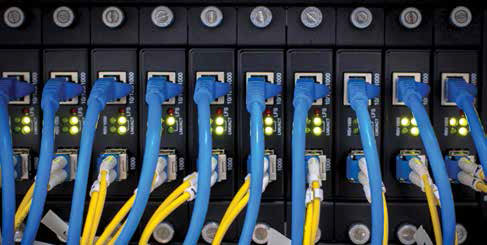We’ve all heard of Ethernet networks and about their wide deployment in the AV industry. But what are the fundamental reasons for their success? And, do we really understand how to use them?
Ethernet networks use an old concept called statistical multiplexing, which was widely used in the early days of data communications. The technique squeezes as many Ethernet frames onto a circuit as possible. They may come from one or more sources. Unlike the initial implementations in the 1980s, Ethernet networks can now pack the frames so densely that almost 100-percent bandwidth utilization is possible. Also, Ethernet is simple and inexpensive to implement.
Ethernet is based on cables and switches. One common misconception is that a network built using a 16-port, 1-gigabit (1Gb) switch can handle only 1 gigabit of traffic. In fact, it can handle 8 gigabits of traffic simultaneously between the eight pairs of ports. Switches are manufactured to be non-blocking. In other words, they can handle traffic on all ports at full line rate without blocking any frames.

When VLANs are used, they do not increase the capacity of the switch. Rather, they allow isolation of the data flows through the switch. For example, suppose that ports 1 and 9 are connected to a server and a client. Likewise, suppose that ports 2 and 10 are connected between an encoder and a digital sign. Ports 1 and 9 can be assigned to one VLAN while ports 2 and 10 are assigned to a second VLAN. Both will have 1 gigabit of bandwidth available and the traffic will be completely separated. This is beneficial because large video flows can severely degrade client-server exchanges. This is the usual reason that IT network managers try to isolate video traffic onto a separate VLAN.
So, in a video-only network, could a 16-port switch support eight 1Gb video flows? The answer is yes, but only if they are connected to a single switch. An entirely different issue is raised if you connect three 16-port switches. It is true that you have 48 total ports, but on each switch, two ports need to be used for switch interconnection. More importantly, each of the inter-switch links has only 1Gb capacity. That’s where we look to the uses of trunking. Trunking allows several switch ports to be combined to act as if they were a single port. Often, up to four ports can be aggregated in this manner. This would allow for the appearance of 4Gb capacity between the switches. Using this technique, four 1Gb video flows could simultaneously flow across the trunk between the two switches.
Finally, it is important to understand why VLANs are probably more critical with video flows than with data or voice flows. Voice packets are very small when compared to video packets. They are less likely to interfere with a company’s standard business data flows. Also, data flows such as file transfers and web surfing use TCP. That protocol automatically enforces a sharing scheme. While the underlying technology of Ethernet is straightforward, careful thought must be given to the design of multiple-switch video networks.
Phil Hippensteel, PhD, is a regular AV Technology contributor. He teaches at Penn State Harrisburg.
